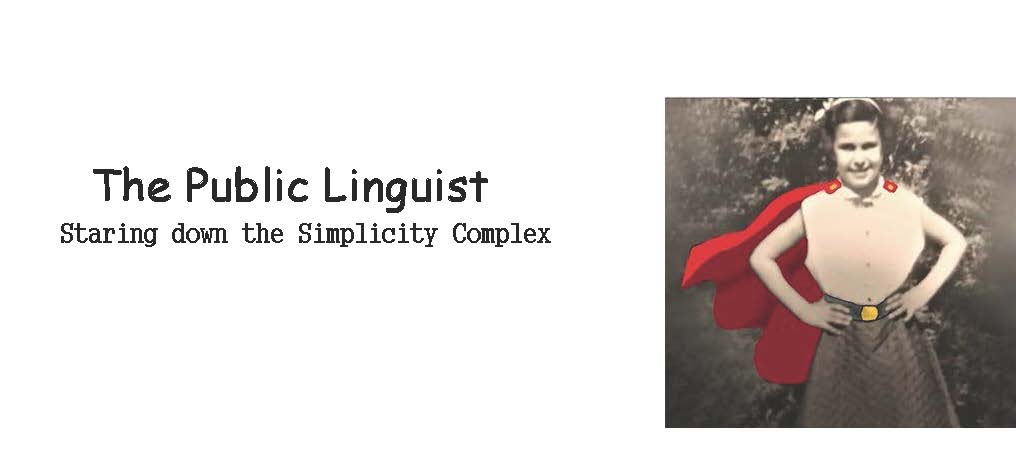It’s hard to find anyone who would argue against keeping things “plain and simple.”
Or would they?
Is it possible that the imperative to create simple health information has over-promised - hasn’t lived up to its billing? What if the complexity of health, science and technology information in the first half of the 21st century requires more than simple simplicity.
Think back to swine flu
November 2009 - we were awash in breaking news, and precautionary recommendations - “Sneeze into your sleeve; wash hands often, stay home if you’re sick”.
Yet when all was said and done, only 35% of parents chose to have their children vaccinated.
Huston - we have a problem.
Why didn’t simple messages communicate and convince people to take action?
December 2009 - I’m loitering, with intent, outside a Harlem NY pharmacy chain store, as I and my students often do, hoping someone will stop and talk about swine flu.
One does, a young woman. I ask, “Why are experts in the city recommending sneeze into our sleeve?
She responds, almost indignant, “For the environment.…You save the paper….”
An elderly man stops to explain to me that he’s fighting the approaching virus thus;
“Well, gotta see what it winds up being. Right now I’m just using that Purell. No more soap and water for me.”
Ah - is this magical thinking?
Well no - it’s health literacy at work.
I’ve been interviewing patients and consumers for over 30 years. Early on it struck me that my hardest and most exhilarating task as a linguist was to listen and try to figure out how people were making meaning of health, science, the world, their lives.
So, in front of the pharmacy, I wound up interrogating myself. What is this person saying and what could it mean about what they understand and use to make choices? What could it mean about their health literacy.
While I didn’t thoroughly study a representative sample of New Yorkers, most people had heard the 3 hygiene messages. But, when I scratched the surface of their understanding of H1N1, things got murky fast.
- What’s the difference between a virus and a bacteria?
- What does it mean that H1N1 is a “new, ‘novel” virus?
- What do vaccines do to protect us and why is it risky to let children “naturally” develop immunity during a pandemic
These more complex concepts and information did not make it into the popular messaging about H1N1. But in order to weigh risks and benefits of vaccination and other precautionary behaviors, the health literate person has some facility with these more complex issues and uses them to make informed decisions.
I’ll conclude with 3 short propositions:
1. Let’s entertain the idea that simplifying health messages is often necessary but hardly ever sufficient. It should not be our primary tactic - the default tactic.
2. Much simplified information results in staccato-like language that create yawning inferential gaps most people simply can’t fill.
3. If we agree that health literacy and health and social equity are related, the singular focus on simplifying, simplifying, simplifying has backgrounded or completely deleted out more complicated and nuanced concepts and information people look for and use.
I believe if we endorsed a change of focus about health literacy and people we would find ourselves talking less about what patients and consumers can’t understand and do, and turn our attention to figuring out what they do have and are using to make meaning and decisions every day.
This post also appears this week at engagingthepatient.com


Great posting! If I may add one more piece to your suggestions, it would be "Listen to people." There is so much more to be learned from listening to people than from doing readability analyses on a piece of paper.
ReplyDeleteSometimes I wonder whether readability formulas are a useful tool for researchers who are uncomfortable talking with people; maybe a personality trait? I recall hearing as a graduate student that some Psychology majors were attracted to experimental psychology, research, statistics, etc. precisely because they didn't have to interact with other people very much--compared to those in clinical psychology.
Years ago I wrote that we didn't need any more studies on consent form readability--the consent forms for clinical trials were unreadable, are unreadable, and will continue to be unreadable. The research should focus more on the people writing the consent forms, and less on the consent forms themselves. Otherwise what you wind up with is 30 years of consent form complaints--but no improvements.
Yet there is so much to be learned from listening to current and prospective subjects, but no one seems interested in doing that. Too qualitative ("anecdotal")? Not scholarly enough for publications, tenure, etc.?
Mark Hochhauser
Mark,
ReplyDeleteI agree that the original 1960's notion of "readability" a la (Flesch, 1951; 1974; Fry, 1968) has been thoroughly distorted. Flesch, a developer of the Flesch-Kincaid, way back then cautioned that he hoped users “won’t take the formula too seriously and won’t expect from it more than a rough estimate”. Evolving ecological models of health literacy are broadening the lens through which we connect health literacy with a range of social, cultural, and environmental determinants of health (Freedman et al., 2009; Kerka, 2003; Kickbusch, 2001; Nutbeam, 1999; Zarcadoolas, Pleasant, & Greer, 2005).
I also agree with you that researchers in health literacy have been preoccupied by demonstrating what consumers/patients can't do, and have used very narrow measures with little theory to back them up.